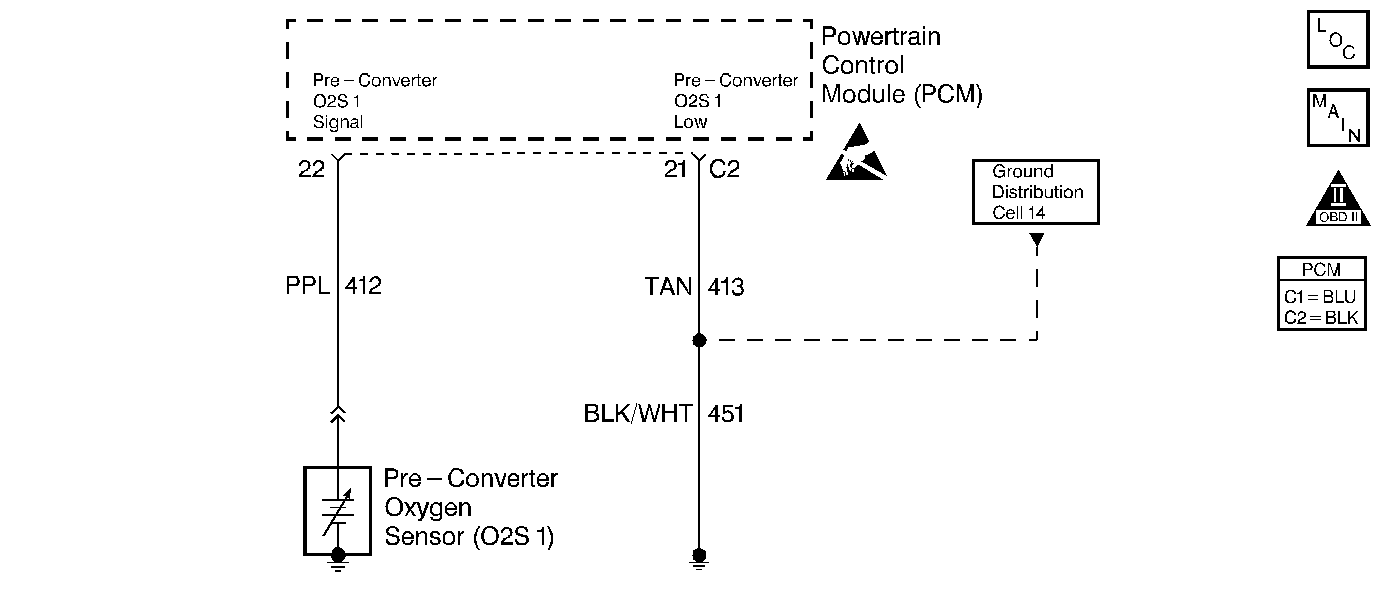
Circuit Description
The powertrain control module (PCM) supplies a reference voltage of about 0.45 volt to the oxygen sensor (O2S). The O2S 1 voltage varies within a range of about 1.0 volt when the exhaust is rich and down to about 0.10 volts when the exhaust is lean.
Conditions For Running The DTC
| • | No active MAP DTCs |
| • | No active IAT DTCs |
| • | No active ECT DTCs |
| • | No active TP DTCs |
| • | No active fuel trim DTCs |
| • | No active injector control DTCs |
| • | No active misfire DTCs |
| • | No active CKP DTCs |
| • | No active EVAP DTCs |
| • | No active IAC DTCs |
| • | No active PCM memory DTCs |
| • | Air flow is more than three grams per second |
| • | Engine coolant temperature (ECT) is more than 70°C (158°F) |
| • | Throttle position (TP) angle is between 4 percent and 56 percent |
| • | The above conditions are met for 20 seconds |
| • | Engine run time is more than 30 seconds |
Conditions For Setting The DTC
O2S 1 voltage is between 399 mV and 499 mV for 125 seconds.
Action Taken When the DTC Sets
| • | The control module illuminates the malfunction indicator lamp (MIL) if a failure is detected during 2 consecutive key cycles. |
| • | The control module sets the DTC and records the operating conditions at the time the diagnostic failed. The failure information is stored in the scan tools Freeze Frame and Failure Records. |
Conditions for Clearing the MIL/DTC
| • | The control module turns OFF the MIL after 3 consecutive drive trips when the test has Run and Passed |
| • | A history DTC will clear if no fault conditions have been detected for 40 warm-up cycles. A warm up cycle occurs when the coolant temperature has risen 22°C (40°F) from the startup coolant temperature and the engine coolant reaches a temperature that is more than 70°C (158°F) during the same ignition cycle. |
| • | Use a scan tool to clear the DTCs. |
Diagnostic Aids
| • | When the oxygen sensor pigtail wiring, connector, or terminal are damaged, the entire oxygen sensor assembly must be replaced. Do not attempt to repair the wiring, the connector, or the terminals. In order for the sensor to function properly, the O2S must have a clean air reference. This clean air reference is obtained by way of the oxygen sensor wires. Any attempt to repair the wires, connectors or terminals, may result in the obstruction of the air reference and degrade the oxygen performance of the sensor. |
| • | The normal scan tool voltage varies between 150 mV to 850 mV (0.15 volts to 0.85 volts) when in a Closed Loop. |
Test Description
The numbers below refer to the step numbers on the diagnostic table:
-
When the system is operating correctly the O2S voltage should toggle above and below the specified values.
-
The specified value is what is measured on a correctly operating system.
-
The specified value is what is measured on a correctly operating system.
-
The replacement PCM must be reprogrammed and the Crankshaft Position System Variation Learn procedure must be preformed.
Step | Action | Value(s) | Yes | No | ||||||||
|---|---|---|---|---|---|---|---|---|---|---|---|---|
1 | Did you perform the Powertrain On-Board Diagnostic (OBD) System Check? | -- | ||||||||||
|
Important:: If any other DTCs are set, refer to the other DTCs before proceeding with this table.
Does the O2S 1 voltage read outside the specified range? | 400-500 mV | |||||||||||
3 | Operate vehicle within the Failure Records conditions. Does the DTC reset? | -- | Go to Diagnostic Aids | |||||||||
4 | Inspect and test for the following conditions:
Did you find and correct the condition? | -- | ||||||||||
Does the O2S 1 signal voltage Measure near the specified value? | 450 mV | |||||||||||
Does the O2S 1 signal voltage Measure near the specified value? | 0 mV | |||||||||||
7 |
Did you find and correct the condition? | -- | ||||||||||
8 |
Did you find and correct the condition? | -- | ||||||||||
9 |
Did you find and correct the condition? | -- | ||||||||||
10 |
Important:: Determine the cause of contamination before replacing the sensor. Inspect and test for the following condition:
Replace the O2S 1. Refer to Oxygen Sensor Replacement . Did you complete the repair? | -- | -- | |||||||||
11 |
Did you find and correct the condition? | -- | ||||||||||
|
Important:: The replacement PCM must be programmed. Replace the PCM. Refer to Powertrain Control Module Replacement/Programming . Did you complete the replacement? | -- | -- | ||||||||||
13 |
Does the DTC reset? | -- | System OK |
